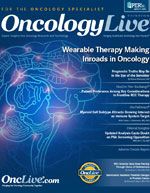Outfitted for Cancer Care
Technology is in the works that would allow medically useful personal health metrics to be collected by sensors that can be incorporated into clothing, accessories, or skin patches, and then transmitted electronically for analysi
OncLive Chairman,
Mike Hennessy
You don’t have to be a market analyst to know that wearable technology has burst onto the healthcare scene in recent years. Think fitness wristbands that monitor heart rates, keep track of steps, and count calories—all in a selection of fashion colors—and you’ve tuned in to one facet of this trend.
That’s just the beginning when it comes to wearables, as these devices are often called. Technology is in the works that would allow medically useful personal health metrics to be collected by sensors that can be incorporated into clothing, accessories, or skin patches, and then transmitted electronically for analysis.
In this issue of OncologyLive, we check in on another aspect of the wearables segment—that is, wearable technology that can deliver therapy instead of simply filling a monitoring function. In the past 10 years, we have seen examples of wearable therapy in other disease states, such as portable oxygen units for patients with chronic obstructive pulmonary disease.
Similar developments have been slow to take root in cancer care but that might be starting to change, as we report in our cover story, “Wearable Therapy Making Inroads in Oncology.”
Optune, which delivers tumor-treating electromagnetic fields to patients with glioblastoma via a skull cap, is portable therapy. DigniCap, which cools the scalp of patients receiving chemotherapy for breast cancer to prevent hair loss, is administered at infusion centers.
The field is attracting many innovators, and we are excited about the prospects of what the future may bring. Patients are well served if they can go about their daily lives during the often long and exhausting journey of cancer care, and technological advances hold the promise of helping them to do that.
However, as with all innovations, any technologies that are properly vetted and validated will need open-minded healthcare practitioners if they are truly to make a difference for patients. That means oncology providers throughout the spectrum of care will have to at least consider whether such devices would make sense for their patients.




